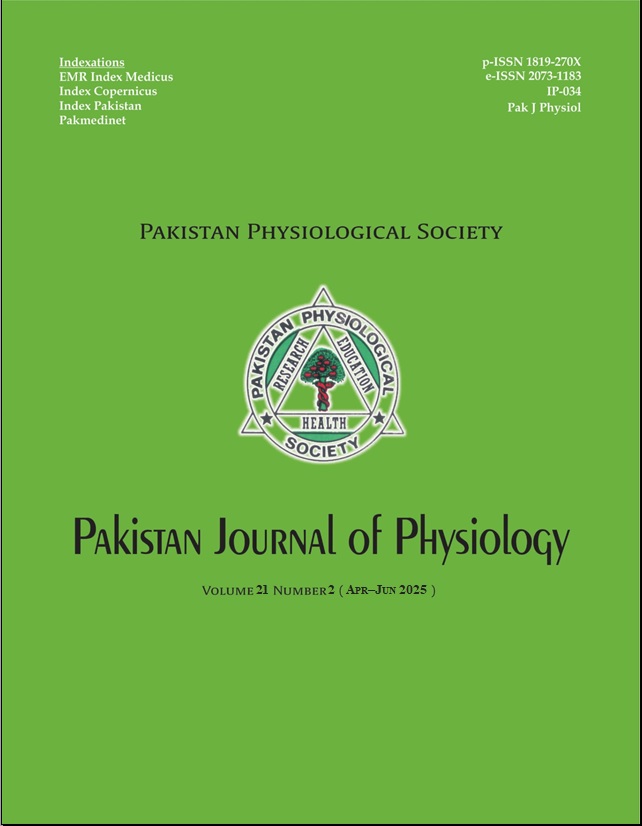ONLINE TEACHING: READINESS AND WILLINGNESS AMONG 1ST AND 2ND YEAR MBBS STUDENTS DURING COVID-19 PANDEMIC —EFFECTS ON PROFESSIONAL EXAMINATION RESULTS
DOI:
https://doi.org/10.69656/pjp.v21i2.1780Keywords:
COVID-19, Online teaching, Readiness, WillingnessAbstract
Background: Online education despite various challenges emerged as the best possible solution to prevent academic loss during COVID-19 pandemic. This study evaluated online teaching for students’ readiness and willingness and its impact on overall performance during COVID-19. Methods: A cross-sectional study was conducted at Gujranwala Medical College, Gujranwala in May-Jul 2020. All students of first and second year MBBS at Gujranwala Medical College were given a voluntary opportunity to fill an online questionnaire regarding their readiness and willing to start online teaching. One hundred and fifty-one (151) students filled and returned the questionnaire. It included basic demographics and questions related to access, knowledge, willingness and problems regarding online teaching. Results: Less than 50% (49.4%) of students were willing to start online teaching; 91.8% students had readily available internet facility at their homes, and 8.2% students were deficient in this facility. Most students (50.6%) had broadband as their internet source. Personal smart phone was the most common (67.1%) gadget available with students likely to be used to take online classes; 73.4% students were aware of some media used for online teaching, whereas 26.6% were not familiar with any one of them. The results of professional examination conducted during pandemic were comparable to subsequent years. Conclusion: In spite of partial willingness of students and limited resources, the learning objectives could be achieved well through online teaching which is evident from examination results. Online teaching is a suitable option during any unpredictable and untoward circumstances.
Pak J Physiol 2025;21(2):56-59, DOI: https://doi.org/10.69656/pjp.v21i2.1780
Downloads
References
Zhu N, Zhang D, Wang W, Li X, Yang B, Song J, et al. A novel coronavirus from patients with pneumonia in China. N Engl J Med 2020;382:727–33.
Alabdulmonem W, Shariq A, Rasheed Z. COVID-19: a global public health disaster. Int J Health Sci (Qassim) 2020;14(3):7–8.
Burki T. Outbreak of coronavirus disease 2019. Lancet 2020;20:292–3.
Imran M, Khan S, Khan S, Uddin A, Khan MS, Ambade P. COVID-19 situation in Pakistan: A broad overview. Respirology 2021;26(9):891–2.
Woolliscroft JO. Innovation in response to the COVID-19 pandemic crisis. Acad Med 2020;95(8):1140–2.
Jiang Z, Wu H, Cheng H, Wang W, Xie A, Fitzgerald SR. Twelve tips for teaching medical students online under COVID-19. Med Educ Online 2021;26(1):1854066.
Ross DA. Creating a “quarantine curriculum” to enhance teaching and learning during the COVID-19 Pandemic. Acad Med 2020;95(8):1125–6.
Irby DM, Cooke M, O’Brien BC. Calls for reform of medical education by the Carnegie Foundation for the Advancement of Teaching: 1910 and 2010. Acad Med 2010;85(2):220–7.
Pei L, Wu H. Does online learning work better than offline learning in undergraduate medical education? A systematic review and meta-analysis. Med Educ Online 2019;24(1):1666538.
Singh HK, Joshi A, Malepati RN, Najeeb S, Balakrishna P, Pannerselvam NK, et al. A survey of e-learning methods in nursing and medical education during COVID-19 pandemic in India. Nurse Educ Today 2021;99:104796.
Siddiqi H, Tahir MJ, Ullah I, Nazir A, Douba Z, Asghar MS, et al. COVID-19 pandemic: Direct effects on the medical education in Pakistan. Ann Med Surg (Lond) 2022;79:104073.
Dost S, Hossain A, Shehab M, Abdelwahed A, Al-Nusair L. Perceptions of medical students towards online teaching during the COVID-19 pandemic: a national cross-sectional survey of 2721 UK medical students. BMJ Open 2020;10(11):e042378.
Latif A, Sajid I. Pakistan closes schools, universities over coronavirus. 2020. https://www.aa.com.tr/en/asia-pacific/pakistan-closes-schools-universities-over-coronavirus/1765276. [Accessed: 14 June 2023]
Mukhtar K, Javed K, Arooj M, Sethi A. Advantages limitations and recommendations for online learning during COVID-19 pandemic era. Pak J Med Sci 2020;36 (COVID19-S4):S27–31.
Alsoufi A, Alsuyihili A, Msherghi A, Elhadi A, Atiyah H, Ashini A, et al. Impact of the COVID-19 pandemic on medical education: medical students’ knowledge, attitudes, and practices regarding electronic learning. Plos One 2020;15(11):e0242905.
Mortagy M, Abdelhameed A, Sexton P, Olken M, Hegazy MT, Gawad MA, et al. Online medical education in Egypt during the COVID-19 pandemic: a nationwide assessment of medical students’ usage and perceptions. BMC Med Educ 2022;22(1):218.
Qazi A, Naseer K, Qazi J, AlSalman H, Naseem U, Yang S, et al. Conventional to online education during COVID-19 pandemic: Do develop and underdeveloped nations cope alike. Child Youth Serv Rev 2020;119:105582.
Al-Araibi AM, Naz’ri bin Mahrin M, Yusoff RCM, Chuprat SB. A model for technological aspect of e-learning readiness in higher education. Educ Info Technol 2019;24(2):1395–1431.
Carvalho VO, Conceicao LSR, Gois MB Jr. COVID-19 pandemic: Beyond medical education in Brazil. J Card Surg 2020;35(6):1170–1.
Sud R, Sharma P, Budhwar V, Khanduja S. Undergraduate ophthalmology teaching in COVID-19 times: students’ perspective and feedback. Indian J Ophthalmol 2020;68(7):1490–1.
Anwar A, Mansoor H, Faisal D, Khan HS. E-learning amid the COVID-19 lockdown: Standpoint of medical and dental undergraduates. Pak J Med Sci 2021;37(1):217–22.
Abbasi S, Ayoob T, Malik A, Memon SI. Perceptions of students regarding e-learning during COVID-19 at a private medical college. Pak J Med Sci 2020;36(COVID19-S4):S57–61.
Downloads
Published
How to Cite
Issue
Section
License
Copyright (c) 2025 Faizania Shabbir, Sabahat Fatima, Tanveer Ahmed Raja

This work is licensed under a Creative Commons Attribution-NoDerivatives 4.0 International License.
The author(s) retain the copyrights and allow their publication in Pakistan Journal of Physiology, Pak J Physiol, PJP to be FREE for research and academic purposes. It can be downloaded and stored, printed, presented, projected, cited and quoted with full reference of, and acknowledgement to the author(s) and the PJP. The contents are published with an international CC-BY-ND-4.0 License.











